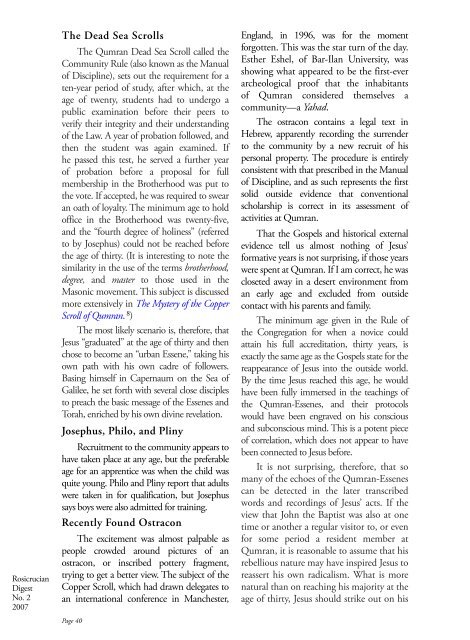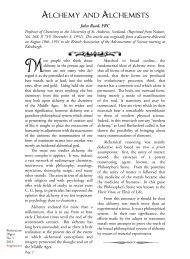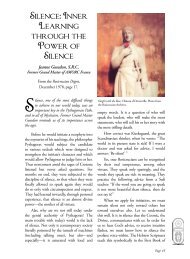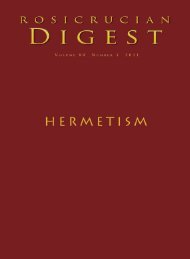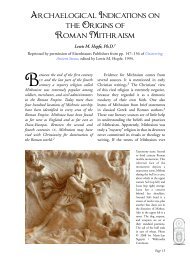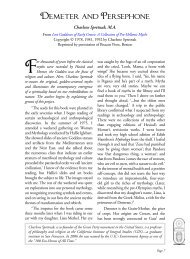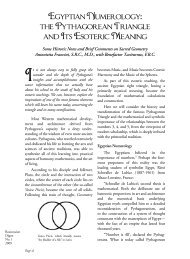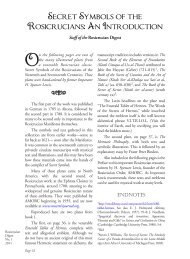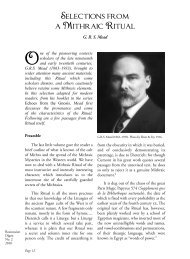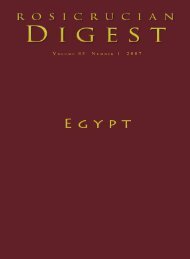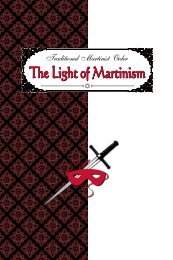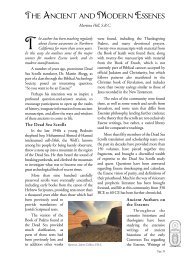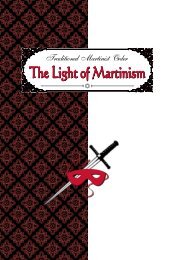Rosicrucian Digest Vol 85 Number 2 2007 - Rosicrucian Order
Rosicrucian Digest Vol 85 Number 2 2007 - Rosicrucian Order
Rosicrucian Digest Vol 85 Number 2 2007 - Rosicrucian Order
You also want an ePaper? Increase the reach of your titles
YUMPU automatically turns print PDFs into web optimized ePapers that Google loves.
<strong>Rosicrucian</strong><br />
<strong>Digest</strong><br />
No. 2<br />
<strong>2007</strong><br />
The Dead Sea Scrolls<br />
The Qumran Dead Sea Scroll called the<br />
Community Rule (also known as the Manual<br />
of Discipline), sets out the requirement for a<br />
ten-year period of study, after which, at the<br />
age of twenty, students had to undergo a<br />
public examination before their peers to<br />
verify their integrity and their understanding<br />
of the Law. A year of probation followed, and<br />
then the student was again examined. If<br />
he passed this test, he served a further year<br />
of probation before a proposal for full<br />
membership in the Brotherhood was put to<br />
the vote. If accepted, he was required to swear<br />
an oath of loyalty. The minimum age to hold<br />
office in the Brotherhood was twenty-five,<br />
and the “fourth degree of holiness” (referred<br />
to by Josephus) could not be reached before<br />
the age of thirty. (It is interesting to note the<br />
similarity in the use of the terms brotherhood,<br />
degree, and master to those used in the<br />
Masonic movement. This subject is discussed<br />
more extensively in The Mystery of the Copper<br />
Scroll of Qumran. 8 )<br />
The most likely scenario is, therefore, that<br />
Jesus “graduated” at the age of thirty and then<br />
chose to become an “urban Essene,” taking his<br />
own path with his own cadre of followers.<br />
Basing himself in Capernaum on the Sea of<br />
Galilee, he set forth with several close disciples<br />
to preach the basic message of the Essenes and<br />
Torah, enriched by his own divine revelation.<br />
Josephus, Philo, and Pliny<br />
Recruitment to the community appears to<br />
have taken place at any age, but the preferable<br />
age for an apprentice was when the child was<br />
quite young. Philo and Pliny report that adults<br />
were taken in for qualification, but Josephus<br />
says boys were also admitted for training.<br />
Recently Found Ostracon<br />
The excitement was almost palpable as<br />
people crowded around pictures of an<br />
ostracon, or inscribed pottery fragment,<br />
trying to get a better view. The subject of the<br />
Copper Scroll, which had drawn delegates to<br />
an international conference in Manchester,<br />
Page 40<br />
England, in 1996, was for the moment<br />
forgotten. This was the star turn of the day.<br />
Esther Eshel, of Bar-Ilan University, was<br />
showing what appeared to be the first-ever<br />
archeological proof that the inhabitants<br />
of Qumran considered themselves a<br />
community—a Yahad.<br />
The ostracon contains a legal text in<br />
Hebrew, apparently recording the surrender<br />
to the community by a new recruit of his<br />
personal property. The procedure is entirely<br />
consistent with that prescribed in the Manual<br />
of Discipline, and as such represents the first<br />
solid outside evidence that conventional<br />
scholarship is correct in its assessment of<br />
activities at Qumran.<br />
That the Gospels and historical external<br />
evidence tell us almost nothing of Jesus’<br />
formative years is not surprising, if those years<br />
were spent at Qumran. If I am correct, he was<br />
closeted away in a desert environment from<br />
an early age and excluded from outside<br />
contact with his parents and family.<br />
The minimum age given in the Rule of<br />
the Congregation for when a novice could<br />
attain his full accreditation, thirty years, is<br />
exactly the same age as the Gospels state for the<br />
reappearance of Jesus into the outside world.<br />
By the time Jesus reached this age, he would<br />
have been fully immersed in the teachings of<br />
the Qumran-Essenes, and their protocols<br />
would have been engraved on his conscious<br />
and subconscious mind. This is a potent piece<br />
of correlation, which does not appear to have<br />
been connected to Jesus before.<br />
It is not surprising, therefore, that so<br />
many of the echoes of the Qumran-Essenes<br />
can be detected in the later transcribed<br />
words and recordings of Jesus’ acts. If the<br />
view that John the Baptist was also at one<br />
time or another a regular visitor to, or even<br />
for some period a resident member at<br />
Qumran, it is reasonable to assume that his<br />
rebellious nature may have inspired Jesus to<br />
reassert his own radicalism. What is more<br />
natural than on reaching his majority at the<br />
age of thirty, Jesus should strike out on his


